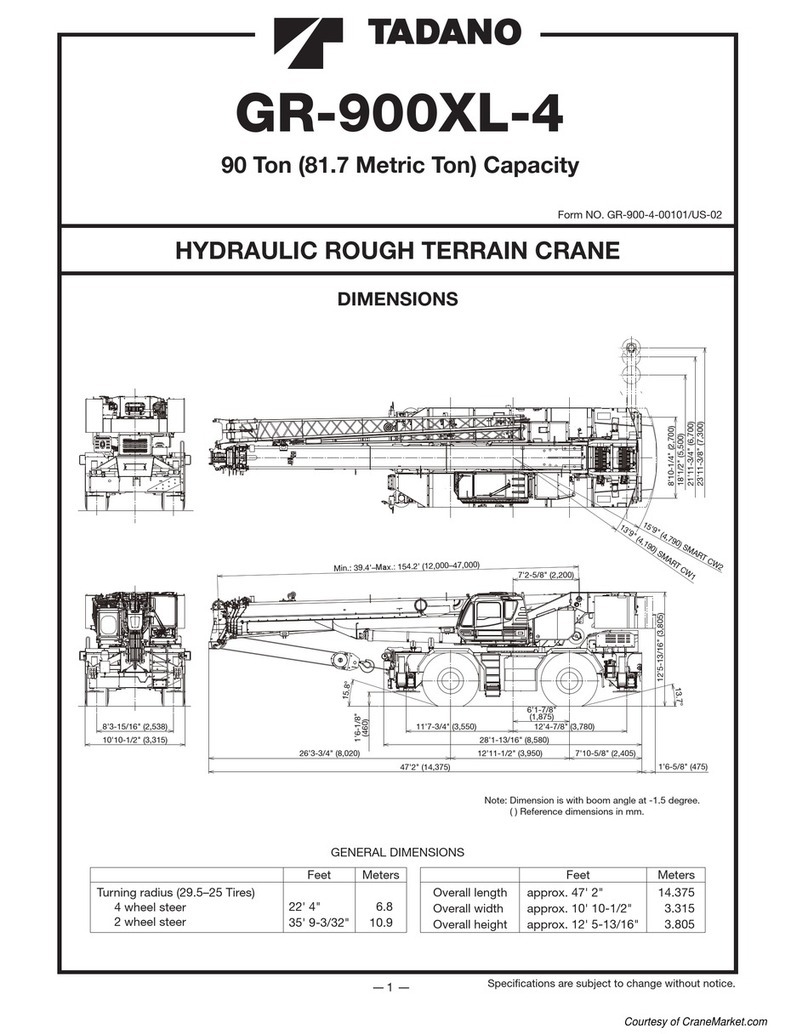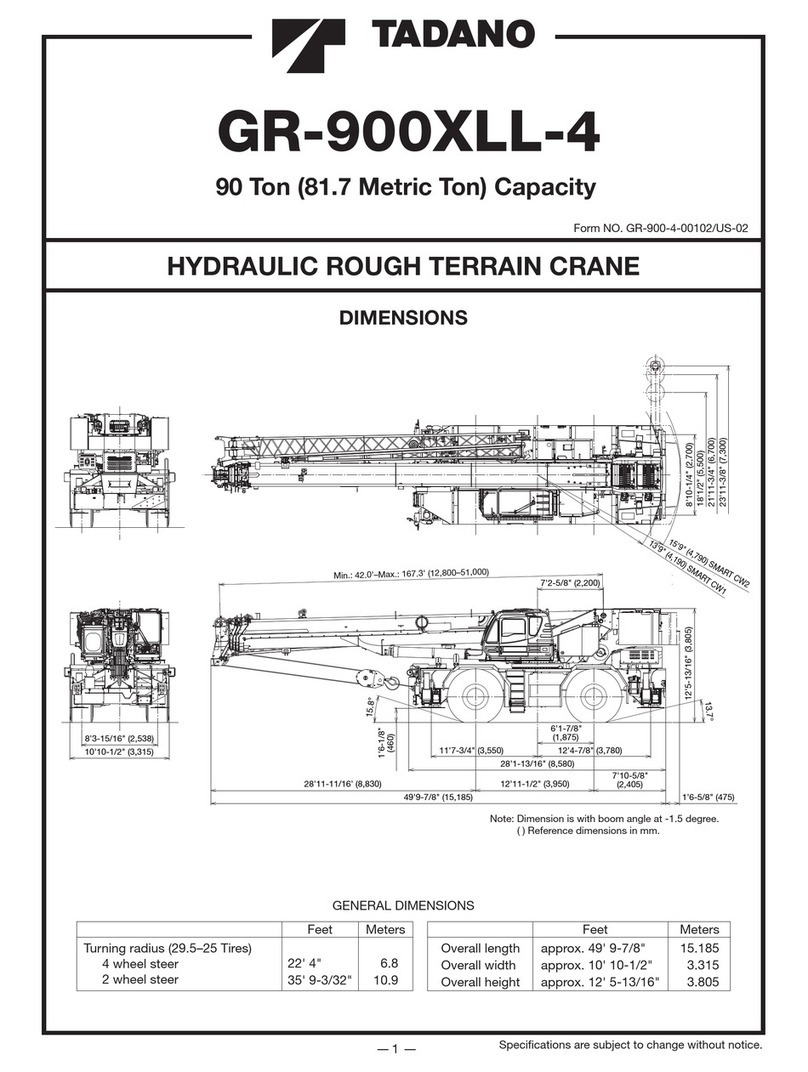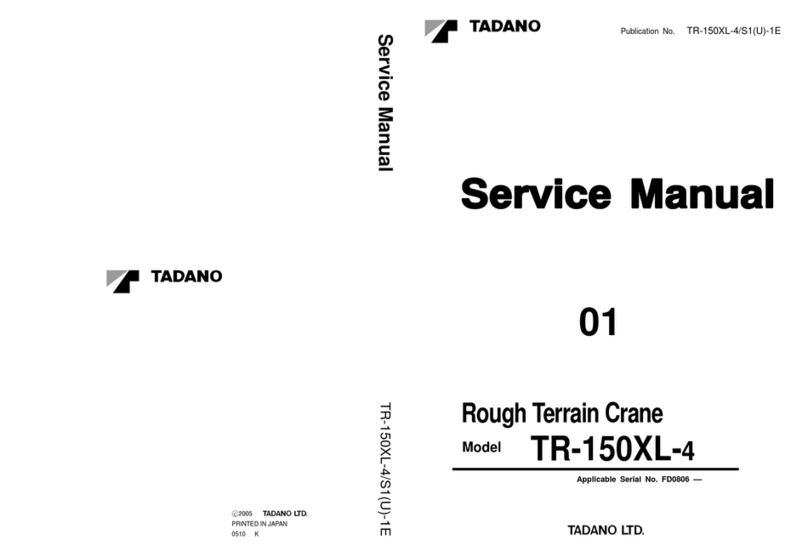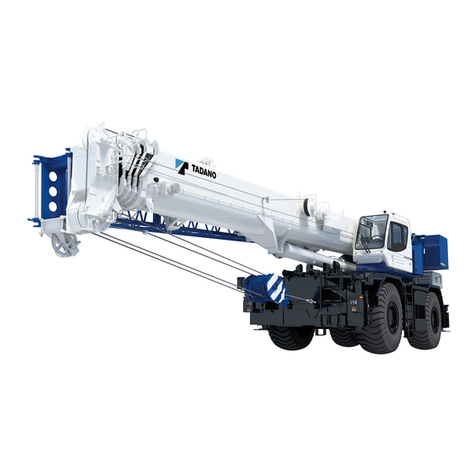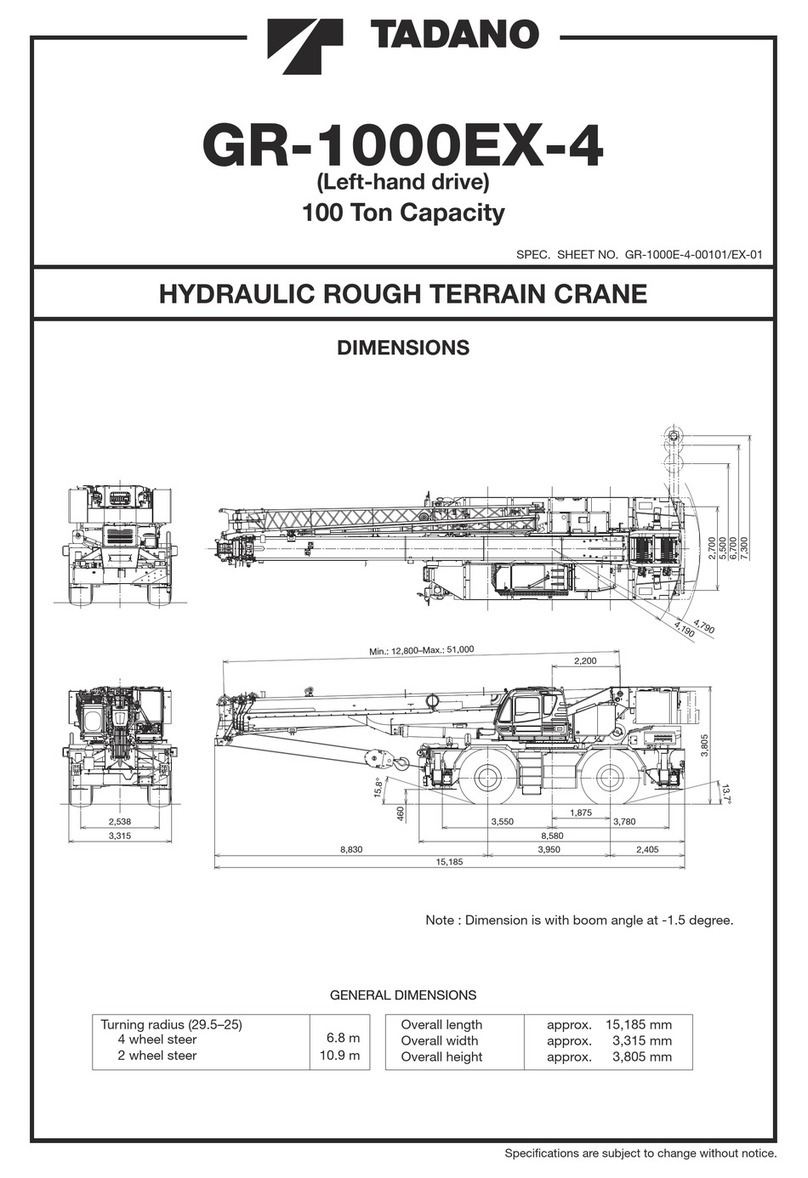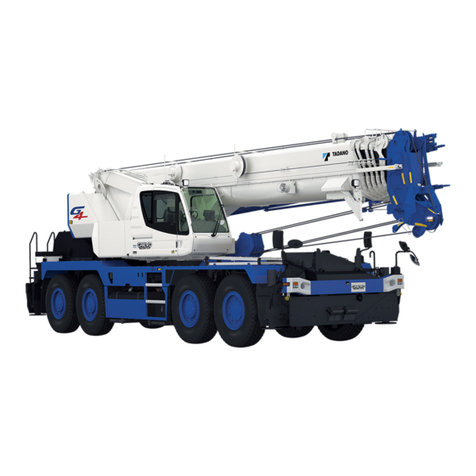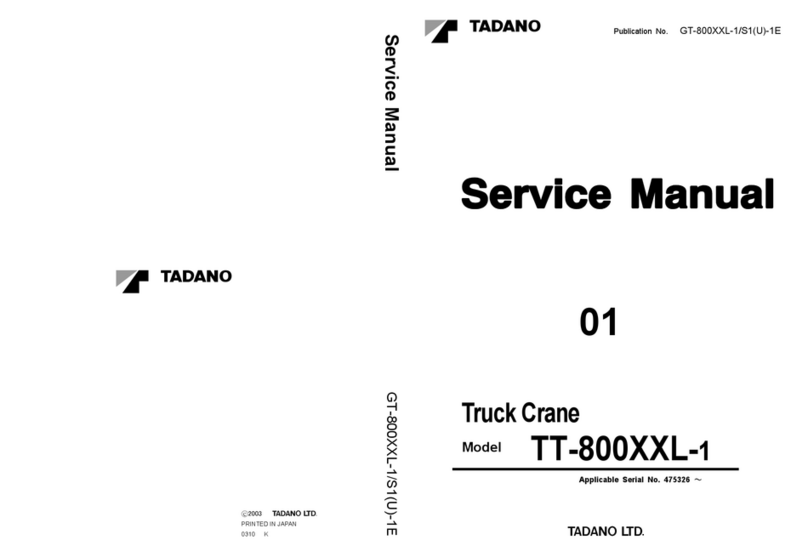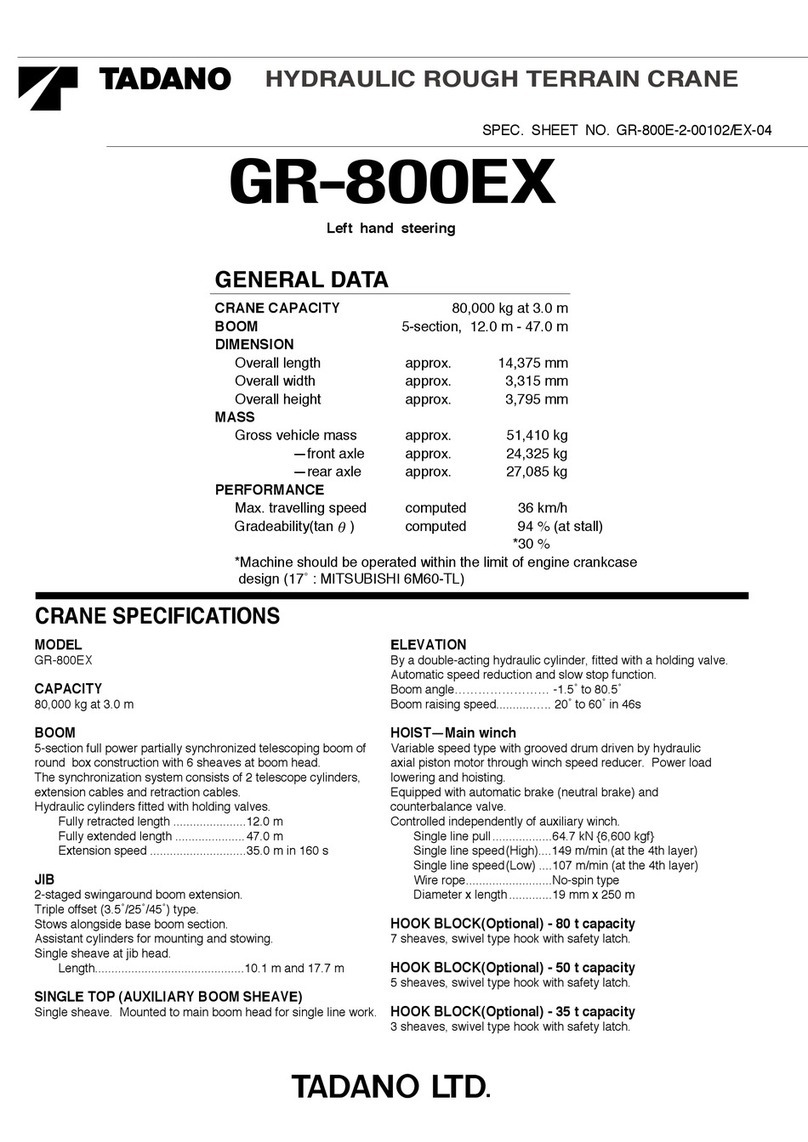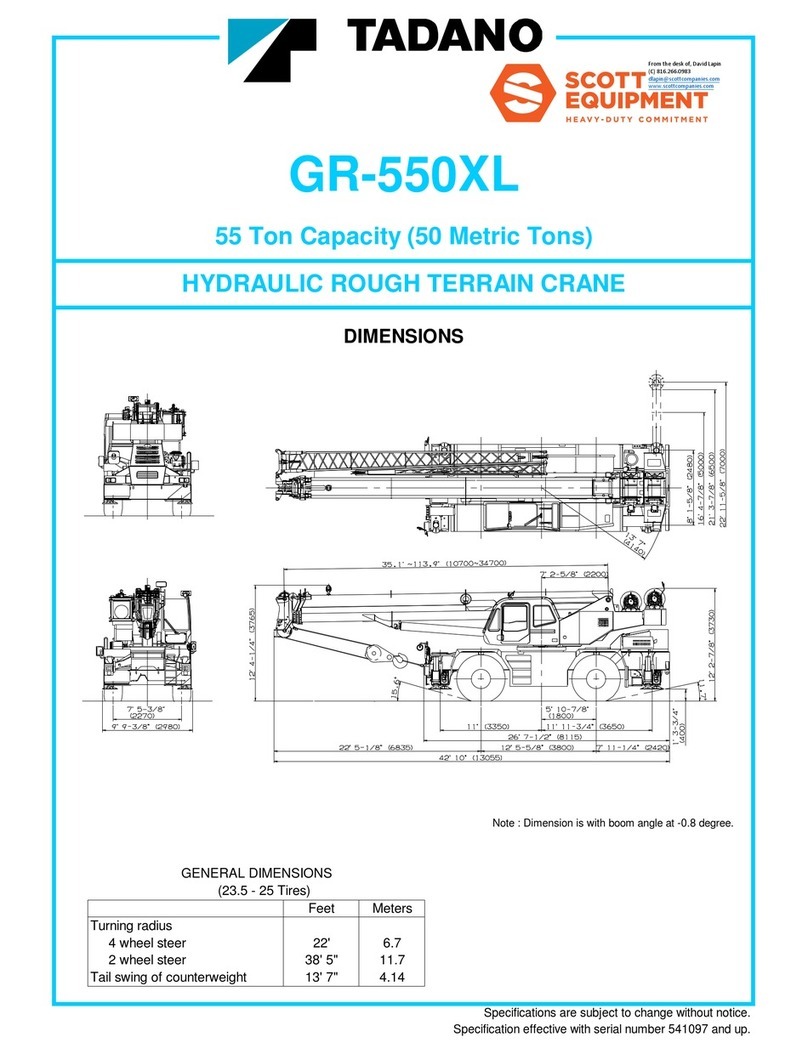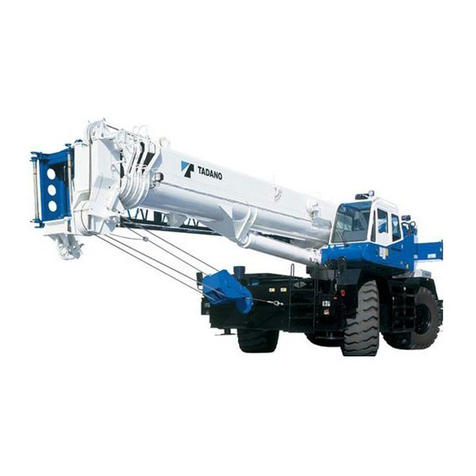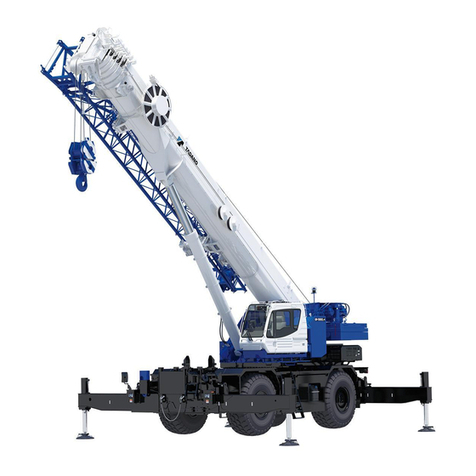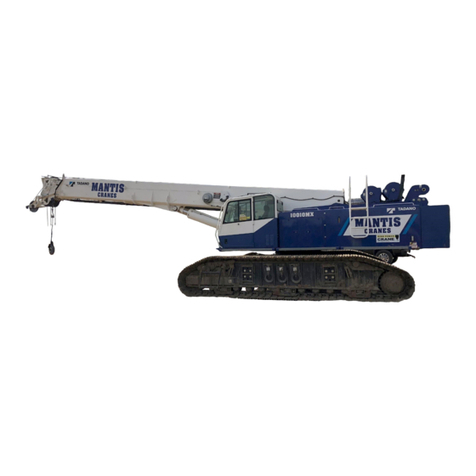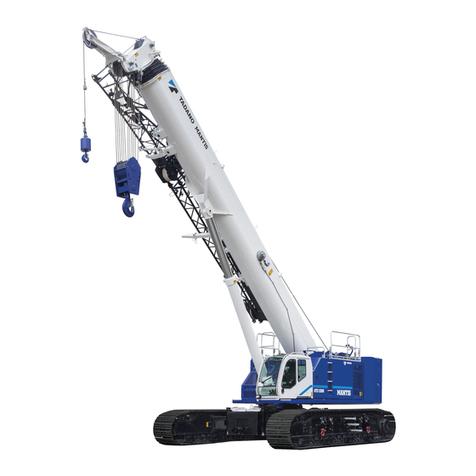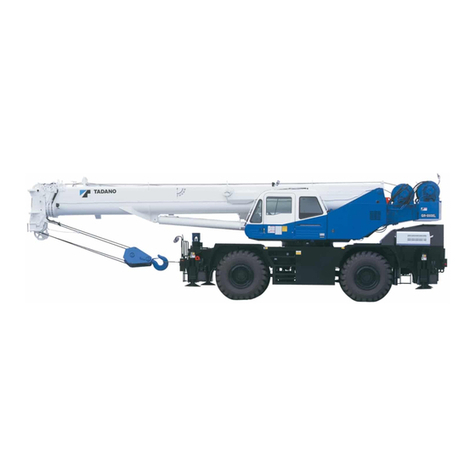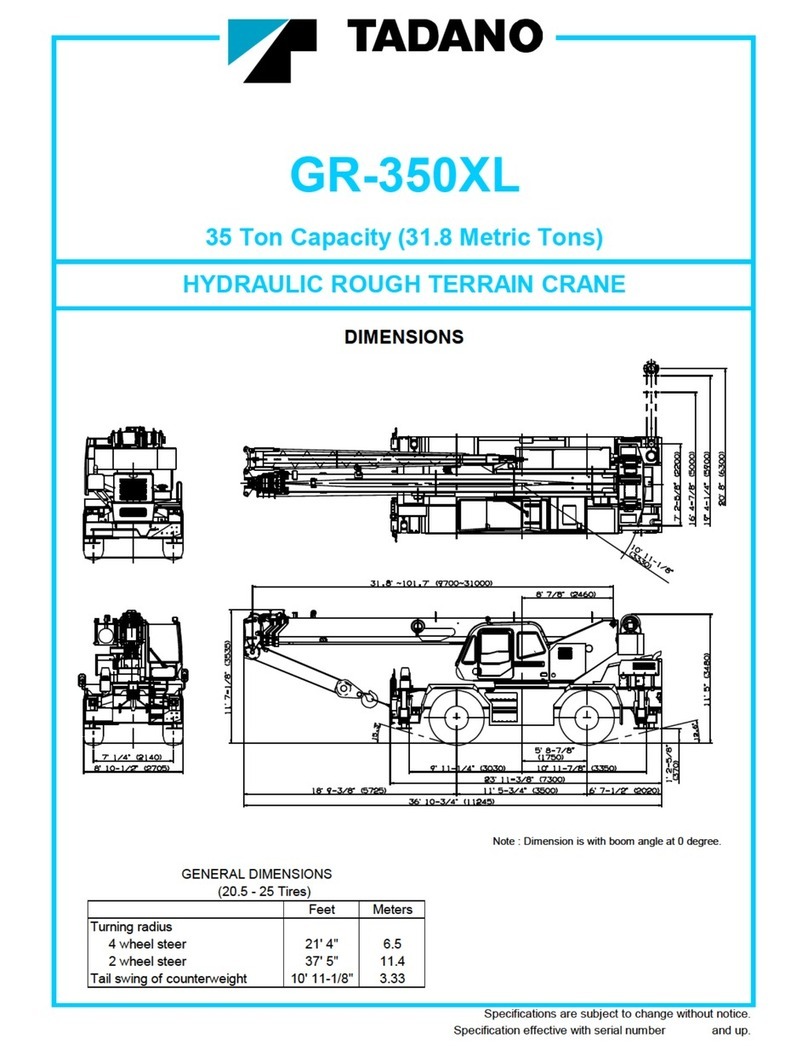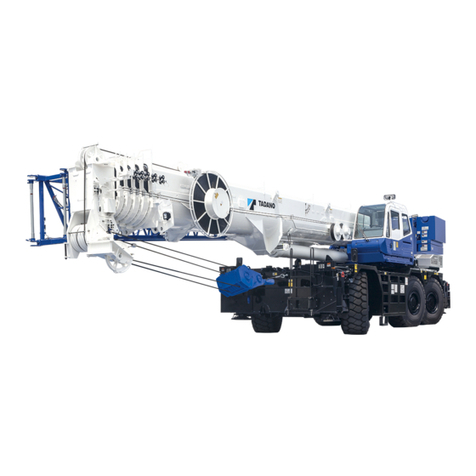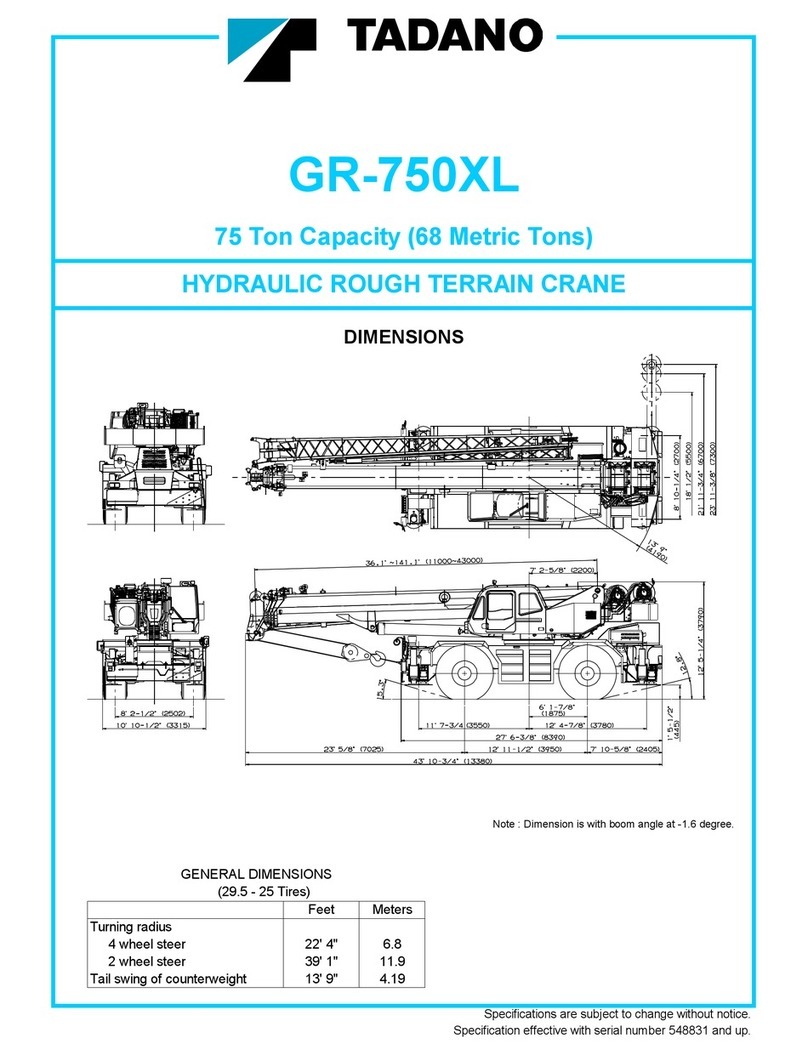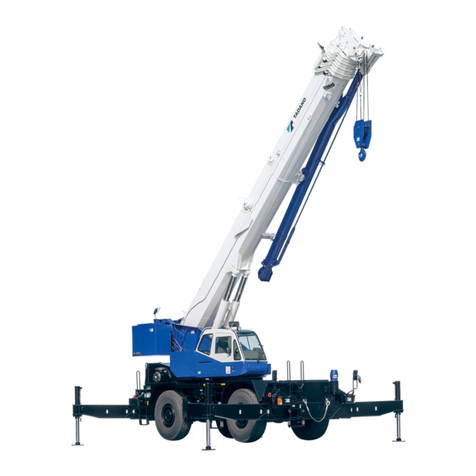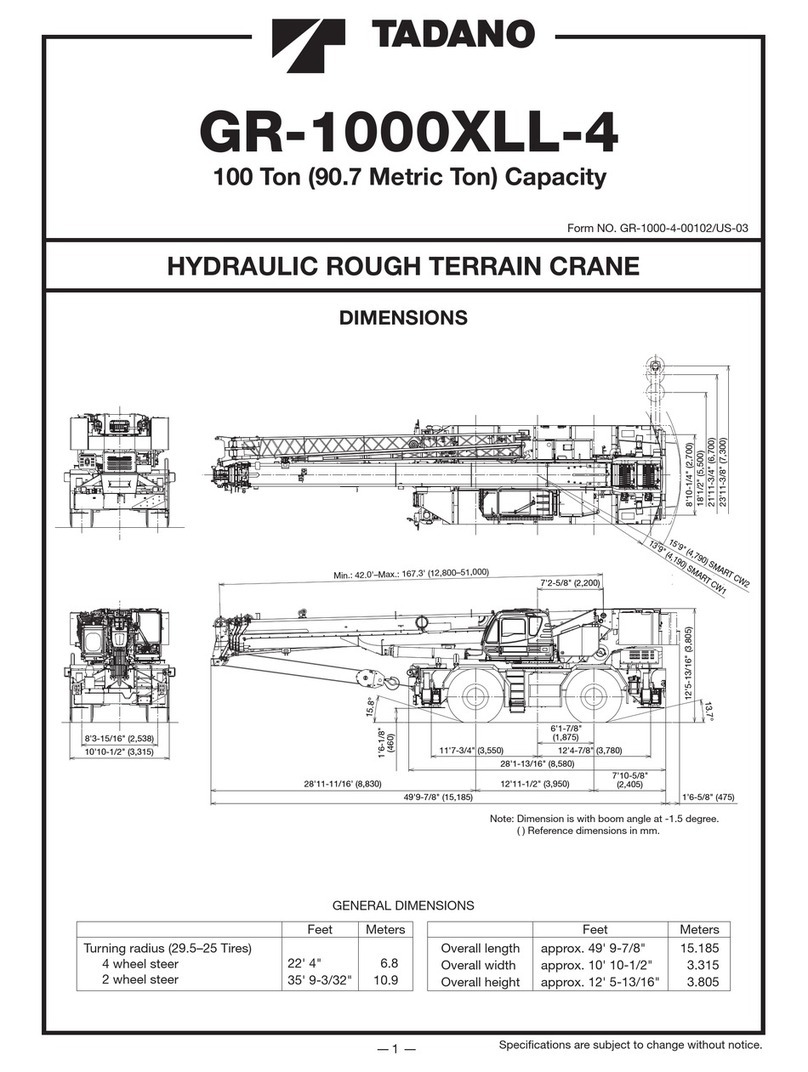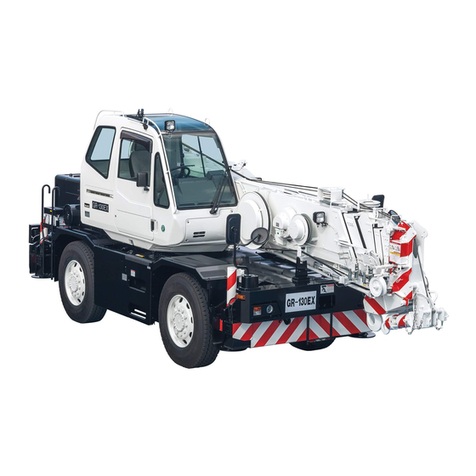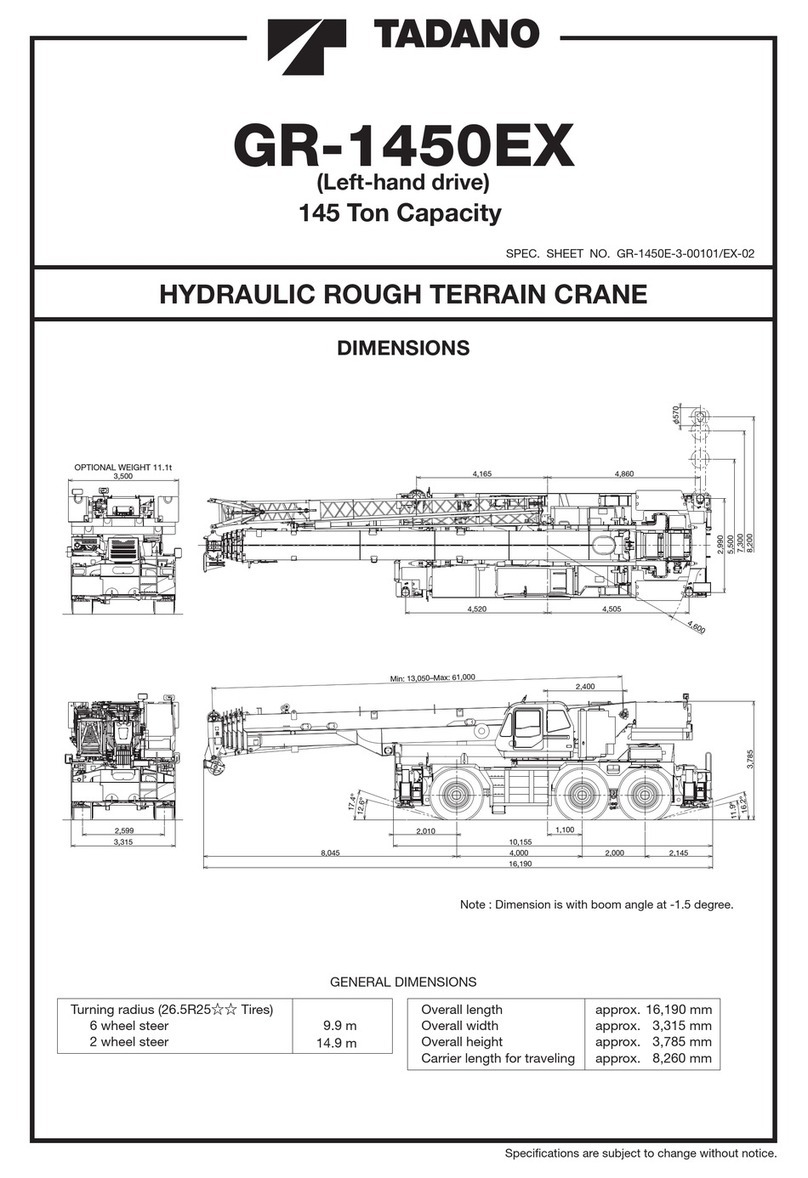
CRANE SPECIFICATIONS
BOOM
6 sections boom of round box construction with 5 sheaves at
boom head, extended by single telescoping cylinder.
2 easily removable wire rope guards, rope dead end provided on
both sides of boom head. Boom telescope sections are
supported by wear pads both vertically and horizontally.
Fully retracted length....... 12.0 m (39.4')
Fully extended length ...... 56.0 m (183.7')
Extension speed.............. 44.0 m (144.3') in 340 s
Sheave root diameter ...... 0.400 m (15-3/4")
BOOM ELEVATION
By a double acting hydraulic cylinder with holding valve.
Boom angle indicator.
Automatic speed reduction and slow stop function.
Boom angle ..................... -1.5–81º
Boom raising speed ........ 20º to 60º in 40 s
JIB
2 stage bi-fold lattice type, 3.5º, 25º or 45º offset.
Single sheave at the head of both jib sections. Stowed alongside
base boom section. Assistant cylinders for mounting and stowing,
controlled at right side of superstructure.
Self stowing jib mounting pins.
Length ............................. 10.1 m, 17.7 m (33.2', 58.1')
Offset............................... 3.5˚, 25˚, 45˚
Sheave root diameter ...... 0.396 m (15-5/8")
AUXILIARY LIFTING SHEAVE (SINGLE TOP)
Single sheave, mounted to main boom head for single line work
(stowable).
Root diameter.................. 0.440 m (17-5/16")
ANTI-TWO BLOCK DEVICE
Pendant type over-winding cut out device with audio-visual
(FAILURE lamp/BUZZER) warning system.
SLEWING
Hydraulic axial piston motor driven through planetary slewing
speed reducer. Continuous 360º full circle slewing on ball bearing
turn table at 1.5 min
-1
{rpm}. Equipped with manually
locked/released slewing brake. A positive swing lock manually
engaged in cab. Twin slewing system: Free slewing or lock
slewing controlled by selector switch on front console.
Slewing speed................. 1.5 min
-1
{rpm}
COUNTERWEIGHT
Standard weight .................... 10,000 kg (22,000 lbs)
WINCH
MAIN WINCH
Variable speed type with grooved drum driven by hydraulic axial
piston motor through speed reducer. Power load lowering and
raising. Equipped with automatic brake (neutral brake) and
counterbalance valve. Controlled independently of auxiliary winch.
Equipped with cable follower and drum rotation indicator.
MAIN DRUM
Root diameter x wide ............. 0.382 m (15") x 0.742 m (29-1/4")
Wire rope diameter x length ........... 19 mm (3/4") x 300 m (984')
Drum capacity ........................................ 394 m (1293'), 7 layers
Maximum single line pull (1st layer).............9,900 kg (21,800 lbs)
Maximum permissible linepull wire strength
...7,200 kg (15,900 lbs)
AUXILIARY WINCH
Variable speed type with grooved drum driven by hydraulic axial
piston motor through speed reducer.
Power load lowering and raising. Equipped with automatic brake
(neutral brake) and counterbalance valve. Controlled
independently of main winch. Equipped with cable follower and
drum rotation indicator.
AUXILIARY DRUM
Root diameter x wide ............. 0.382 m (15") x 0.742 m (29-1/4")
Wire rope diameter x length ........... 19 mm (3/4") x 158 m (518')
Drum capacity ........................................ 394 m (1293'), 7 layers
Maximum single line pull (1st layer).............9,900 kg (21,800 lbs)
Maximum permissible linepull wire strength
...7,200 kg (15,900 lbs)
WIRE ROPE
Non-rotating 19 mm (3/4") 7x35 class.
Breaking Strength 36,000 kg (79,400 lbs)
HOOK BLOCKS
110 metric ton (120 ton, option).. 8 sheaves with hook block and
safety latch.
70 metric ton (77 ton, option)...... 5 sheaves with hook block and
safety latch.
45 metric ton (50 ton, option) .... 3 sheaves with hook block and
safety latch.
7.2 metric ton (9.9 ton) ..............Weighted hook with swivel and
safety latch.
HYDRAULIC SYSTEM
PUMPS
2 variable piston pumps for crane functions.
Tandem gear pump for steering, swing and optional equipment.
Powered by carrier engine. Pump disconnect for crane is
engaged/ disengaged by rotary switch from operator's cab.
CONTROL VALVES
Multiple valves actuated by pilot
pressure with integral pressure relief valves.
RESERVOIR
763 lit. (202 gallon) capacity. External sight level gauge.
FILTRATION
BETA10=10 return lter, full ow with bypass protection, located
inside of hydraulic reservoir. Accessible for easy replacement.
OIL COOLER
Air cooled fan type.
CAB AND CONTROLS
Both crane and drive operations can be performed from one
cab mounted on rotating superstructure.
15º tilt, Left side, 1 man type, steel construction with sliding door
access and safety glass windows opening at side. Door window is
powered control. Windshield glass window and roof glass window
are shatter-resistant. Tilt-telescoping steering wheel. Adjustable
control lever stands for swing, boom elevating, boom telescoping,
auxiliary winch and main winch. Control lever stands can change
neutral positions and tilt for easy access to cab. 3 way adjustable
operator's seat with high back, headrest and armrest. Engine
throttle knob. Foot operated controls: boom elevating boom
telescoping, service brake and engine throttle. Hot water cab
heater and air conditioning.
Dash-mounted engine start/stop, monitor lamps, cigarette
lighter, drive selector switch, parking brake switch, steering mode
select switch, power window switch, pump engaged/ disengaged
switch, swing brake switch, telescoping/auxiliary winch select
switch, outrigger controls, free swing / lock swing selector switch,
eco mode switch, high speed winch (main/aux) switch and
ashtray.
Instruments - Torque converter oil temperature, engine water
temperature, air pressure, fuel, speedometer, tachometer, hour
meter and odometer / tripmeter. Hydraulic oil pressure is
monitored and displayed on the AML-C display panel.
-
2
-
SPEC. SHEET NO. GR-1200-3-00104/ES-04
